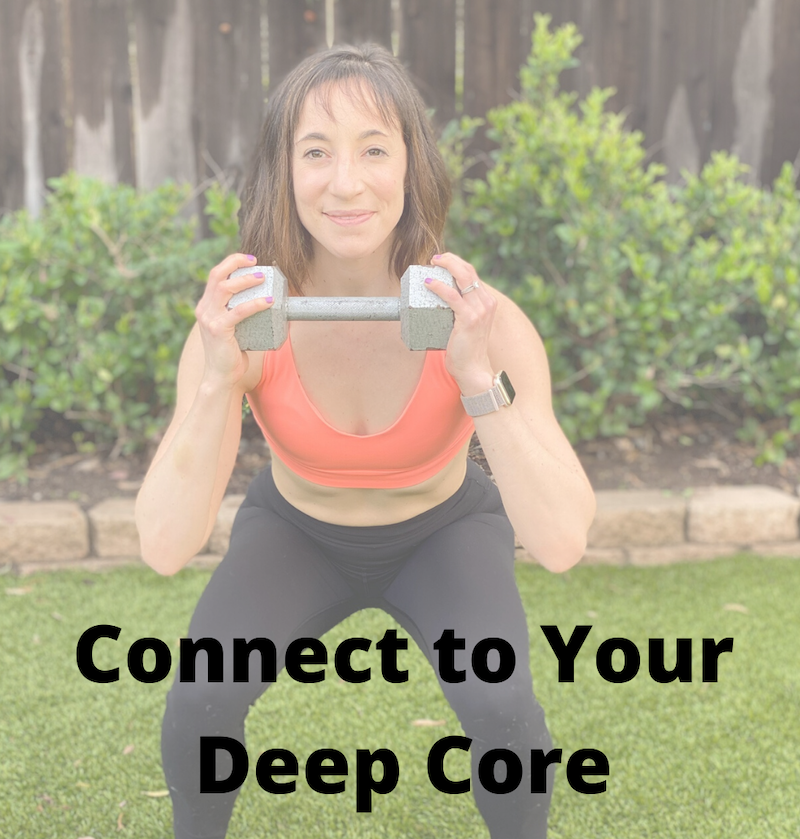How to Connect to your Deep Core + Pelvic Floor
Can you connect to your deep core and pelvic floor?
Honestly, this was THE hardest thing for me to figure out postpartum. I'm still practicing! It takes a ton of time to master, but it's so important for long-term function and recovery.
Step One of a Postnatal Fitness Program
Learning how to connect to your core and pelvic floor is step one in a Postnatal Fitness Program. We also focus on breath, alignment, and strategies for performing activities of daily life as a parent (like bending over to pick up toys) before adding more layers (and weight).
Once you've mastered breath, alignment, and the core + pelvic floor connection, we can continue to add on layers. Progression through a program is based on how well you can consistently activate the muscles you want at the appropriate times to do their job. This isn't just important for pregnant and postpartum women - it's important for everyone (men too!).
Cues for Core + Pelvic Floor Engagement
Below are some of my favorite cues to get the pelvic floor and core working as one team.
Jellyfish: As a jellyfish swims it's a constant up and down through the water. The diaphragm sits under our ribs. On the inhale we are releasing and lengthening, the pelvic floor relaxes. On the exhale, the jellyfish comes together. Inhale to relax, exhale life.
The Puppet String: The Puppet String is my favorite cue for performing a deadlift or squat movement. Imagine there's a puppet string that runs from your pelvic floor up through the top of your head. As we squat down the puppet string is loose / relaxed. As we stand up, the puppet string is pulled, lifting the pelvic floor up. Think about lifting the pelvic floor, middle abs, and upper abs (the way up towards the top of your head).
Diamond: Imagine your Pelvic Floor is shaped like a diamond (sit bone to sit bone and tail bone to pubic bone) and try to draw all four points together.
Ice Cube - The Ice Cube is my favorite tactile cue when laying on your belly (prone). Imagine a cold ice cube right under your belly button. On the inhale your belly is going to touch the ice cube (brr). On the exhale, you scoop belly in and up and away from the ice cube. For pregnancy, try on your hands and knees leaning on to a chair.
Blueberry: Try to pick up a blueberry with your vagina. Inhale to release blueberry and relax the pelvic floor. On the exhale you lift the blueberry with your vagina. Squeeze with about 30% effort - don't crush the blueberry!
How do you know if you're doing it right?
Take a look at your shouldersShoulders rising up towards your ears may be a sign that you're breathing "backwards." Backwards breathing happens when we focus on the "drawing in" on the inhale, instead of expansion. Backwards breathing increases intra-abdominal pressure and has the opposite effect of the 360 breath we want to achieve.Why does this matter? Backwards breathing often results in more shallow breaths, increased energy use / inefficient use of energy, and can often lead to neck and shoulder pain long-term. We don't want that! This is super common among people who sit a lot and individuals who keep their bellies pulled in a lot (sucking in). This is why I like to say, "Let it go!"via GIPHYTake a look at your ribs
On the inhale breath our ribs should expand outward as you breath into your sides, back, and belly. The 360 breath is similar to opening an umbrella. To practice, place your hands just underneath your ribs right at your bra line. On your inhale, belly should expand, pelvic floor relaxes, and feel your hands gently move away from center. By letting the belly fully relax, the diaphragm has room to move downward and the pelvic floor will reflexively relax as well. One awesome team!
I love this mini breathing tutorial from Julie Wiebe that shows what we're working towards with breath, and why it's important. https://www.youtube.com/watch?v=Ojo1gEJgEtk&feature=emb_title
What about the exhale breath?
Took a look at your hip bones on the front side of the body. Inhale and belly expands, pelvic floor relaxes. Then on the exhale, pelvic floor draws up in and in (check out cues above) as the hip bones draw towards one another. As you exhale and engage, the belly button will draw in and UP! Think about lifting from the bottom up. You should actually see the belly button move. One tip I learned from
is if you see a "bulging" out of the lower abs, take a moment to reset. You may be engaging too "hard." Remember, 30% effort at most. Need some help getting started? I offer 1:1 in person and virtual consults and refer out to some amazing Pelvic Floor PTs.
As always, feel good mama.
xoxo,
Erica

